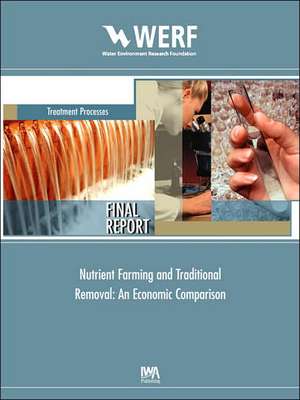Nutrient Farming and Traditional Removal: Werf Report
Autor Donald L. Hey, Jill A. Kostel, Arthur Hurteren Limba Engleză Paperback – noi 2006
Din seria Werf Report
- 23%
 Preț: 962.89 lei
Preț: 962.89 lei - 23%
 Preț: 788.16 lei
Preț: 788.16 lei - 23%
 Preț: 810.88 lei
Preț: 810.88 lei - 23%
 Preț: 800.03 lei
Preț: 800.03 lei - 23%
 Preț: 785.77 lei
Preț: 785.77 lei - 23%
 Preț: 801.91 lei
Preț: 801.91 lei - 23%
 Preț: 790.52 lei
Preț: 790.52 lei - 23%
 Preț: 800.96 lei
Preț: 800.96 lei - 23%
 Preț: 793.14 lei
Preț: 793.14 lei - 23%
 Preț: 795.48 lei
Preț: 795.48 lei - 23%
 Preț: 791.26 lei
Preț: 791.26 lei - 23%
 Preț: 797.16 lei
Preț: 797.16 lei - 23%
 Preț: 812.30 lei
Preț: 812.30 lei - 23%
 Preț: 783.21 lei
Preț: 783.21 lei - 23%
 Preț: 810.41 lei
Preț: 810.41 lei - 23%
 Preț: 789.58 lei
Preț: 789.58 lei - 23%
 Preț: 793.60 lei
Preț: 793.60 lei - 23%
 Preț: 800.50 lei
Preț: 800.50 lei - 23%
 Preț: 834.40 lei
Preț: 834.40 lei - 23%
 Preț: 884.92 lei
Preț: 884.92 lei - 23%
 Preț: 797.62 lei
Preț: 797.62 lei - 23%
 Preț: 786.96 lei
Preț: 786.96 lei - 23%
 Preț: 799.03 lei
Preț: 799.03 lei - 23%
 Preț: 786.75 lei
Preț: 786.75 lei - 23%
 Preț: 798.57 lei
Preț: 798.57 lei - 23%
 Preț: 798.57 lei
Preț: 798.57 lei - 23%
 Preț: 834.62 lei
Preț: 834.62 lei - 23%
 Preț: 839.61 lei
Preț: 839.61 lei - 23%
 Preț: 798.57 lei
Preț: 798.57 lei - 23%
 Preț: 965.97 lei
Preț: 965.97 lei
Preț: 827.42 lei
Preț vechi: 1074.57 lei
-23% Nou
Puncte Express: 1241
Preț estimativ în valută:
158.33€ • 165.72$ • 131.78£
158.33€ • 165.72$ • 131.78£
Carte tipărită la comandă
Livrare economică 27 martie-02 aprilie
Preluare comenzi: 021 569.72.76
Specificații
ISBN-13: 9781843397335
ISBN-10: 1843397331
Pagini: 56
Dimensiuni: 210 x 279 x 3 mm
Greutate: 0.15 kg
Editura: IWA Publishing (Intl Water Assoc)
Seria Werf Report
Locul publicării:United Kingdom
ISBN-10: 1843397331
Pagini: 56
Dimensiuni: 210 x 279 x 3 mm
Greutate: 0.15 kg
Editura: IWA Publishing (Intl Water Assoc)
Seria Werf Report
Locul publicării:United Kingdom














